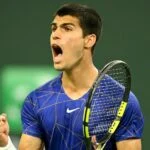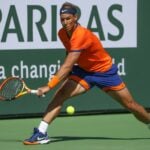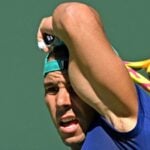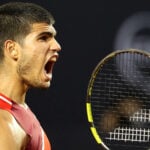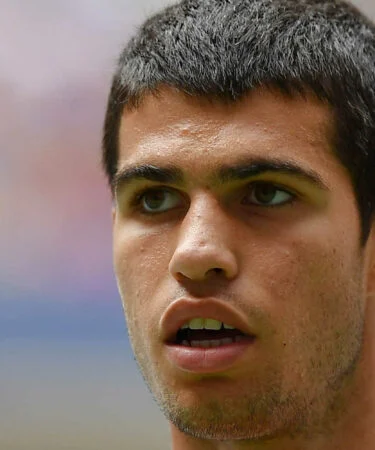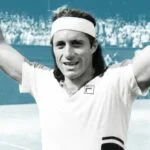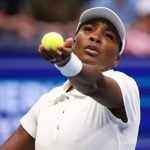Nadal and Alcaraz: why you should – and shouldn’t – compare them
Spanish tennis’s legend and its new great hope will face each other this Saturday in the semi-finals of Indian Wells. The similarities between the two are obvious – or are they?
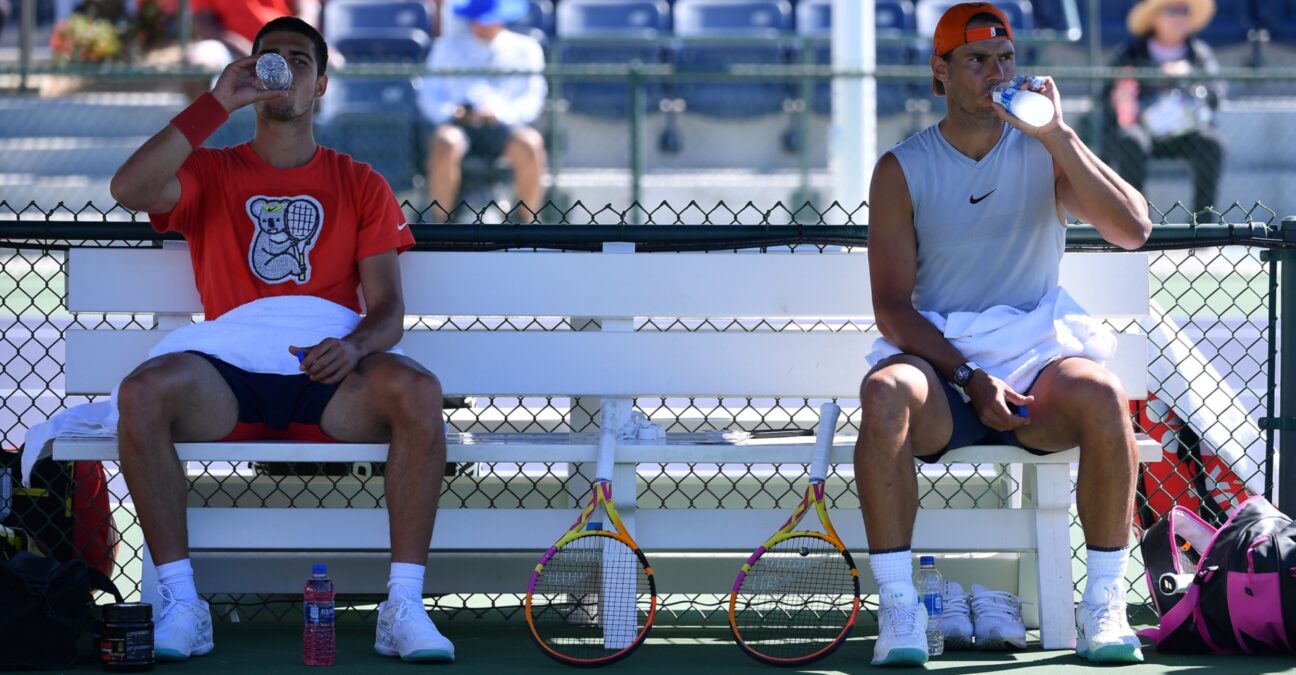 Rafael Nadal and Carlos Alcaraz at practice (Panoramic)
Rafael Nadal and Carlos Alcaraz at practice (Panoramic)
“Since we started working together, one point has been made clear for both of us: he is Carlos Alcaraz, and comparisons are not great.”
In the interview he gave to Tennis Majors at the end of 2020, Juan Carlos Ferrero, the coach of the Spanish teenager, was keen to make it clear from the outset: no, his player is not the designated heir to Rafael Nadal, let alone a version 2.0. The former French Open winner has too much experience not to have sensed the trap. It was better for Alcaraz to avoid carrying such a burden so early on in his career.
Alcaraz himself, who has of course heard his coach shield him from the Nadal comparisons, rarely misses an opportunity to hammer home the point – without necessarily convincing anyone – that his game is more like that of a Federer than a Nadal. It’s a fair observation. But the young Spaniard can’t do much to hide his nationality, nor the size of his biceps or the darkness of his pronounced eyebrows. Nor, of course, his physical and emotional maturity, which is quite astonishing for his 18 years (19 in May): whether he likes it or not – and it is understandable that he doesn’t – everything about him evokes you-know-who.
Nadal and Alcaraz trained together
The two men, who shared a testosterone-fuelled training session before the tournament began, will meet again this Saturday in the semi-finals of the BNP Paribas Open. They will play in the day’s second men’s singles match, after Taylor Fritz faces Andrey Rublev, at around 10pm UK time.
On Thursday, after his quarter-final win over Nick Kyrgios, Nadal himself admitted that Alcaraz did remind him of himself at the same age.
“I think he has the passion. He has the talent and the physical component that is great.”
There is another similarity too: just as with Nadal with coach Carlos Moya, Alcaraz is also coached by a Spanish former champion of the 1990s, who very quickly took him under his wing at his Equelite academy in Villena.
In any case, despite his words, Alcaraz does nothing to detach himself from the trajectory of his prestigious compatriot. His performance in California could ensure him – barring a win in the final for Taylor Fritz – a place in the top 15 next Monday at the age of 18 years, 10 months and 16 days (he was born on 5 May 2003), a day older than Nadal (born on 3 June 1986), who did the same at 18 years, 10 months and 15 days, the day after his 2005 Monte Carlo title.
While it took him a little longer (relatively speaking) than his illustrious predecessor to win his first match on the main circuit (16 years and 9 months in Rio 2020 compared to 15 years and 10 months in Mallorca 2002 for Nadal), Alcaraz has since followed in his footsteps. He was exactly the same age (give or take eight days) when he won his first ATP title at Umag last July at the age of 18 years and two months. For Nadal it was in Sopot, in August 2004.
And he is also, again give or take a few days, the same age when he reached his first Masters 1000 semi-final, here in Indian Wells. In 2005, Nadal did the same at the Miami tournament, where he went all the way to the final, losing to Roger Federer after leading two sets to none.
An earlier quarter-final for Alcaraz
Alcaraz did need less time than Nadal to reach his first major quarter-final (last year, at 18 years and four months, when he became the youngest Grand Slam quarter-finalist since Michael Chang at Roland Garros in 1990). And he now has the chance of outdoing Nadal by winning his first Masters 1000 title at a younger age.
To do so, he will have to unseat the idol, something he came nowhere near doing last year in Madrid, when Nadal won 6-1, 6-2 on the youngster’s 18th birthday.
Since then, a lot of water has flowed under the bridge. Nadal has certainly kept his legend alive and is still on course for the best start to a season in his entire career, but Alcaraz is not the same player that he was last year. He has grown in stature – both physically and psychologically – and if he did beat Nadal at Indian Wells, it would not be a shock.
“I sincerely believe he can beat him,” says former French player Julien Varlet, now a coach at the French Touch Academy and a consultant for Canal Plus and Winamax. “We know that on hard court, you have to be able to deprive Nadal of time. Korda almost beat him playing like that. And Alcaraz is quite capable of playing like that too.”
The former world No 135 played Nadal twice in 2003 when the Spaniard was still a teenager, most notably at the Aix-en-Provence Challenger where he took a set from him. For him, while Alcaraz has obviously not won anything of note – picking up his first ATP 500 in Rio last month – he is perhaps even more impressive at the same age.
“When I played Rafa, he was already a champion in terms of attitude, but his game was still very defensive, more in strength, I want to say less talented. Alcaraz is ahead in variation and creation of the game. He serves better, he does more things. In fact, he is very versatile: he has this capacity to adapt to the opponent while being strong and powerful. That’s perhaps the most impressive thing about him. And it’s true that when you see that, you say to yourself: f***, but how far can he go?”
Nobody knows yet. But apart from his dominant hand (the right one), it is this more aggressive style of play than Nadal at the same age that most distinguishes him from the Majorcan. Many see Alcaraz as a Rafa, while he considers himself closer to a Federer, and some even see Djokovic in his rigour at the back of the court and his very ascetic approach to his craft.
The Big Three wrapped up in one
“Everyone is getting excited about him, and that’s normal, because he’s a monster and people are waiting for the next generation of the Big Three,” says Julien Varlet. “But Alcaraz synthesises the qualities of all three. A lot of fans see them in him. He’s probably the player of the future, quite simply.”
Or perhaps of the present. Since his nightmarish defeat against Hugo Gaston at the Rolex Paris Masters, where he was knocked down by the left-hander’s aggression as much as by the energy of the Bercy crowd, Alcaraz has become unstoppable. He has only lost one match since, and that was in the fifth-set tiebreak against Matteo Berrettini in the third round of the Australian Open.
His rise to prominence is reminiscent of Nadal in 2005, who at the same age played in that Miami final before exploding during the clay-court season to win his first of 13 French Open titles at the age of just 19 – the same age that Carlos Alcaraz will be in May.
Does this mean that we can predict a similar explosion next spring on a surface that remains, if not his favourite, at least the one that is inscribed in his DNA as a Spanish player? We are not there yet. But we are not far from it.
The “small” difference for Alcaraz is that he will have to deal with the still very active presence of the best male clay-court player in history, in addition to Novak Djokovic, who will be making his return to clay. There is also some uncertainty as to whether he will be able to mentally and physically cope with a fortnight of three-set victories, as he finished last year’s New York campaign injured.
But frankly, the boy is growing up so fast that it should not really be a concern. Observers will know more about Alcaraz’s immediate future tonight after this confrontation of compatriots. As Alcaraz admitted, playing Nadal is “a very special experience” for him.
And it will be a match that strongly resembles an initiation rite. We dare not say a passing of the baton.
